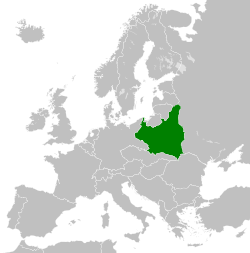Second Republic of Poland
| Republic of Poland | ||||||
| Rzeczpospolita Polska | ||||||
|
||||||
|
||||||
|
Anthem Mazurek Dąbrowskiego Poland Is Not Yet Lost |
||||||
|
Location and extent of the
Second Polish Republic in Europe (circa 1930). |
||||||
| Capital | Warsaw | |||||
| Languages | Polish (official), Ukrainian, Yiddish, Belarusian, Russian Lithuanian, German |
|||||
| Religion |
1931 census: 64.8% Roman Catholic 11.8% Eastern Orthodox 10.5% Greek Catholic 9.8% Jewish 2.6% Protestant 0.5% Other Christian ~0.02% Other |
|||||
| Government | Republic | |||||
| President | ||||||
| • | 1918–1922 | Józef Piłsudskia | ||||
| • | 1922 | Gabriel Narutowicz | ||||
| • | 1922–1926 | Stanisław Wojciechowski | ||||
| • | 1926–1939 | Ignacy Mościcki | ||||
| Prime Minister | ||||||
| • | 1918–1919 (first) | Jędrzej Moraczewski | ||||
| • | 1936–1939 (last) | Felicjan S. Składkowski | ||||
| Legislature | Sejm | |||||
| • | Upper chamber | Senate | ||||
| • | Lower chamber | Sejm | ||||
| Historical era | Interwar period | |||||
| • | End of World War I | 11 November 1918 | ||||
| • | German invasion | 1 September 1939 | ||||
| • | Soviet invasion | 17 September 1939 | ||||
| • | Fall of Warsaw | 28 September 1939 | ||||
| • | Complete occupation | 6 October 1939 | ||||
| Area | ||||||
| • | 1921 | 387,000 km² (149,422 sq mi) | ||||
| • | 1931 | 388,634 km² (150,052 sq mi) | ||||
| • | 1938 | 389,720 km² (150,472 sq mi) | ||||
| Population | ||||||
| • | 1921 est. | 27,177,000 | ||||
| Density | 70.2 /km² (181.9 /sq mi) | |||||
| • | 1931 est. | 32,107,000 | ||||
| Density | 82.6 /km² (214 /sq mi) | |||||
| • | 1938 est. | 34,849,000 | ||||
| Density | 89.4 /km² (231.6 /sq mi) | |||||
| Currency | Marka (until 1924) Złoty (after 1924) |
|||||
| Today part of |
|
|||||
| a. | As Chief of State (Naczelnik Państwa). | |||||
The Second Polish Republic, also known as the Second Commonwealth of Poland or interwar Poland, refers to the country of Poland between the First and Second World Wars (1918–1939). Officially known as the Republic of Poland or the Commonwealth of Poland (Polish: Rzeczpospolita Polska), the Polish state was recreated in 1918, in the aftermath of World War I. When, after several regional conflicts, the borders of the state were fixed in 1922, Poland's neighbours were Czechoslovakia, Germany, the Free City of Danzig, Lithuania, Latvia, Romania and the Soviet Union. It had access to the Baltic Sea via a short strip of coastline either side of the city of Gdynia. Between March and August 1939, Poland also shared a border with the then-Hungarian governorate of Subcarpathia. Despite internal and external pressures, it continued to exist until 1939, when Poland was invaded by Nazi Germany, the Soviet Union and the Slovak Republic, marking the beginning of World War II in Europe. The Second Republic was significantly different in territory to the current Polish state. It included substantially more territory in the east and less in the west.
...
Wikipedia



